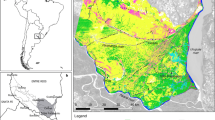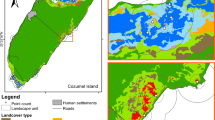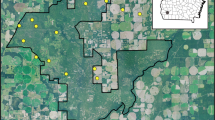Abstract
Landscape features influence distribution of waterbirds throughout their annual cycle. A conceptual model, the wetland habitat complex, may be useful in conservation of wetland habitats for dabbling ducks (Anatini). The foundation of this conceptual model is that ducks seek complexes of wetlands containing diverse resources to meet dynamic physiological needs. We included flooded croplands, wetlands and ponds, public-land waterfowl sanctuary, and diversity of habitats as key components of wetland habitat complexes and compared their relative influence at two spatial scales (i.e., local, 0.25-km radius; landscape, 4-km) on dabbling ducks wintering in western Mississippi, USA during winters 2002–2004. Distribution of mallard (Anas platyrhynchos) groups was positively associated with flooded cropland at local and landscape scales. Models representing flooded croplands at the landscape scale best explained occurrence of other dabbling ducks. Habitat complexity measured at both scales best explained group size of other dabbling ducks. Flooded croplands likely provided food that had decreased in availability due to conversion of wetlands to agriculture. Wetland complexes at landscape scales were more attractive to wintering ducks than single or structurally simple wetlands. Conservation of wetland complexes at large spatial scales (≥5,000 ha) on public and private lands will require coordination among multiple stakeholders.

Similar content being viewed by others
References
Anderson JT, Smith LM (1999) Carrying capacity and diel use of managed playa wetlands by nonbreeding waterbirds. Wildl Soc Bull 27:281–291
Baldassarre GA, Bolen EG (2006) Waterfowl ecology and management, 2nd edn. Kriegler Publishing, Malabar
Brown M, Dinsmore JJ (1986) Implications of marsh size and isolation for marsh bird management. J Wildl Manag 50:392–397
Burnham KP, Anderson DR (2002) Model selection and multimodel inference: a practical information-theoretic approach, 2nd edn. Springer, New York
Cox RR Jr, Afton AD (1996) Evening flights of female northern pintails from a major roost site. Condor 98:810–819
Cox RR Jr, Afton AD (1997) Use of habitats by female northern pintails wintering in southwestern Louisiana. J Wildl Manag 61:435–443
Czech HA, Parsons KC (2002) Agricultural wetlands and waterbirds: a review. Waterbirds 25:56–65
Davis BE, Afton AD, Cox RR Jr (2009) Habitat use by female mallards in the lower Mississippi Alluvial Valley. J Wildl Manag 73:701–709
Delnicki D, Reinecke KJ (1986) Mid-winter food use and body weights of mallards and wood ducks in Mississippi. J Wildl Manag 50:43–51
Dubovsky JA, Kaminski RM (1992) Waterfowl and American coot habitat associations with Mississippi catfish ponds. Proc Southeast Assoc Fish Wildl Agencies 46:10–17
Dwyer TJ, Krapu GL, Janke DM (1979) Use of prairie pothole habitat by breeding mallards. J Wildl Manag 43:526–531
Elphick CS (2000) Functional equivalency between rice fields and seminatural wetland habitats. Conserv Biol 14:181–191
Elphick CS (2008) Landscape effects on waterbird densities in California rice fields: taxonomic differences, scale-dependence, and conservation implications. Waterbirds 31:62–69
Environmental Systems Research Institute (1996) Using ArcView GIS. Environmental Systems Research Institute, Redlands
Evans DM, Day KR (2002) Hunting disturbance on a large shallow lake: the effectiveness of waterfowl refuges. Ibis 144:2–8
Fairbairn SE, Dinsmore JJ (2001) Local and landscape-level influences on wetland bird communities of the Prairie Pothole Region of Iowa, USA. Wetlands 21:41–47
Fleming KS (2010) Effects of management and hydrology on vegetation, winter waterbird use, and water quality on wetlands reserve program lands, Mississippi. Thesis. Mississippi State University
Fleskes JP, Jarvis RL, Gilmer DS (2003) Selection of flooded agricultural fields and other landscapes by female northern pintails wintering in Tulare Basin, California. Wildl Soc Bull 31:793–803
Foster MA, Gray MJ, Kaminski RM (2010) Agricultural seed biomass for migrating and wintering waterfowl in the southeastern United States. J Wildl Manag 74:489–495
Fredrickson LH, Heitmeyer ME (1988) Waterfowl use of forested wetlands of the southern United States: an overview. In: Weller MW (ed) Waterfowl in winter. University of Minnesota Press, Minneapolis, pp 307–323
Fredrickson LH, Taylor TS (1982) Management of seasonally flooded impoundments for wildlife. U.S. Fish and Wildlife Service, Resource Publication 148
Fredrickson LH, King SL, Kaminski RM (eds) (2005) Ecology and management of bottomland hardwood systems: the state of our understanding. University of Missouri-Columbia, Gaylord Memorial Laboratory Special Publication No. 10. Puxico, Missouri, USA
Fretwell SD (1972) Populations in a seasonal environment. Princeton University Press
Gordon DH, Gray BT, Kaminski RM (1998) Dabbling duck-habitat associations during winter in coastal South Carolina. J Wildl Manag 62:569–580
Gotelli NJ, Ellison AM (2004) A primer of ecological statistics. Sinauer Associates, Inc., Sunderland
Guillemain M, Mondain-Monval JY, Weissenbacher E, Brochet AL, Olivier A (2008) Hunting bag and distance from nearest day-roost in Camargue ducks. Wildl Biol 14:379–385
Hagy HM, Kaminski RM (2012) Winter waterbird and food dynamics in autumn-managed moist-soil wetlands in the Mississippi Alluvial Valley. Wildlife Society Bulletin 36: In press
Heitmeyer ME (1988a) Body composition of female mallards in winter in relation to annual cycle events. Condor 90:669–680
Heitmeyer ME (1988b) Protein costs of prebasic molt in female mallards. Condor 90:263–266
Heitmeyer ME, Vohs PA Jr (1984) Characteristics of wetlands used by migrant dabbling ducks in Oklahoma, USA. Wildfowl 35:61–70
Johnson DH (1980) The comparison of usage and availability measurements for evaluating resource preference. Ecology 61:65–71
Kaminski RM, Weller MW (1992) Breeding habitats of Nearctic waterfowl. In: Batt BDJ, Anderson MG, Ankney CD, Johnson DH, Kadlec JA, Krapu GL (eds) Ecology and management of breeding waterfowl. Univeristy of Minnesota Press, Minneapolis, pp 568–589
Kaminski RM, Davis JB, Essig HW, Gerard PD, Reinecke KJ (2004) True metabolizable energy for wood ducks from acorns compared to other waterfowl foods. J Wildl Manag 67:542–550
Krapu GL (1974) Feeding ecology of pintail hens during reproduction. Auk 91:278–290
Krapu GL, Duebbert HF (1989) Prairie wetlands: characteristics, importance to waterfowl, and status. In: Shaitz RR, Gibbons JW (eds) Freshwater wetlands and wildlife, U.S. Department of Energy Symposium, Series 61. U.S. Department of Energy, Washington, D.C., Office of Scientific and Technical Information, Oak Ridge, Tennessee, pp 811–828
Kross J, Kaminski RM, Reinecke KJ, Penny EJ, Pearse AT (2008) Moist-soil seed abundance in managed wetlands in the Mississippi Alluvial Valley. J Wildl Manag 72:707–714
LaGrange TG, Dinsmore JJ (1989) Habitat use by mallards during spring migration through central Iowa. J Wildl Manag 53:1076–1081
Loesch CR, Kaminski RM (1989) Winter body-weight patterns of female mallards fed agricultural seeds. J Wildl Manag 53:1081–1087
Lower Mississippi Valley Joint Venture Management Board (1990) Conserving waterfowl and wetlands: the Lower Mississippi Valley Joint Venture. North American Waterfowl Management Plan, Vicksburg
Madsen J (1998) Experimental refuges for migratory waterfowl in Danish wetlands II. Testing hunting disturbance effects. J Appl Ecol 35:398–417
Madsen J, Fox AD (1995) Impacts of hunting disturbance on waterbirds—a review. Wildl Biol 1:193–207
Manley SW, Kaminski RM, Rodrigue PB, Dewey JC, Schoenholtz SH, Gerard PD, Reinecke KJ (2009) Soil and nutrient retention in winter-flooded ricefields with implications for watershed management. J Soil Water Conserv 64:173–182
McGarigal K, Marks BJ (1992) FRAGSTATS: spatial pattern analysis program for quantifying landscape structure. General Technical Report PNW-GTR-351. US Department of Agriculture, Forest Service, Pacific Northwest Research Station, Portland, Oregon
McKinney RA, McWilliams SR, Charpentier MA (2006) Waterfowl-habitat associations during winter in an urban North Atlantic estuary. Biol Conserv 132:239–249
Mitsch WJ, Gosselink JG (2007) Wetlands, 4th edn. Wiley, Hoboken
Montgomery DC, Peck EA, Vining GG (2006) Introduction to linear regression analysis, 4th edn. Wiley, New York
Nagelkerke NJD (1991) A note on a general definition of the coefficient of determination. Biometrika 78:691–692
National Agricultural Statistics Service (2002–2004) Cropland data layer. http://www.nass.usda.gov/research/Cropland/SARS1a.htm. Accessed 24 Jan 2008
Naugle DE, Johnson RR, Estey ME, Higgins KF (2000) A landscape approach to conserving wetland bird habitat in the Prairie Pothole Region of eastern South Dakota. Wetlands 20:588–604
Nelms CO, Twedt DJ (1996) Seed deterioration in flooded agriculture fields during winter. Wildl Soc Bull 24:85–88
Norton-Griffiths M (1975) Counting animals. Serengeti Ecological Monitoring Programme, African Wildlife Leadership Foundation, Nairobi
Pearse AT (2007) Design, evaluation, and applications of an aerial survey to estimate abundance of wintering waterfowl in Mississippi. Dissertation, Mississippi State University
Pearse AT, Dinsmore SJ, Kaminski RM, Reinecke KJ (2008a) Evaluation of an aerial survey to estimate abundance of wintering ducks in western Mississippi. J Wildl Manag 72:1413–1419
Pearse AT, Gerard PD, Dinsmore SJ, Kaminski RM, Reinecke KJ (2008b) Estimation and correction of visibility bias associated with aerial surveys of wintering ducks. J Wildl Manag 72:808–813
Pollock KH, Kendall WL (1987) Visibility bias in aerial surveys: a review of estimation procedures. J Wildl Manag 51:502–510
Reinecke KJ, Baxter CK (1996) Waterfowl habitat management in the Mississippi Alluvial Valley. In: Ratti JT (ed) 7th International Waterfowl Symposium. Ducks Unlimited, Inc., Memphis, pp 159–167
Reinecke KJ, Krapu GL (1986) Feeding ecology of sandhill cranes during spring migration in Nebraska. J Wildl Manag 50:71–79
Reinecke KJ, Loesch CR (1996) Integrating research and management to conserve wildfowl (Anatidae) and wetlands in the Mississippi Alluvial Valley, USA. Gibier Faune Sauvage, Game Wildfowl 13:927–940
Reinecke KJ, Kaminski RM, Moorhead DJ, Hodges JD, Nassar JR (1989) Mississippi Alluvial Valley. In: Smith LM, Pederson RL, Kaminski RM (eds) Habitat management for migrating and wintering waterfowl in North America. Texas Tech University Press, Lubbock, pp 203–247
Reinecke KJ, Brown MW, Nassar JR (1992) Evaluation of aerial transects for counting wintering mallards. J Wildl Manag 56:515–525
Riffell SK, Keas BE, Burton TM (2001) Area and habitat relationships of birds in Great Lakes coastal wet meadows. Wetlands 21:492–507
Riffell SK, Keas BE, Burton TM (2003) Birds in North American Great Lakes coastal wet meadows: is landscape context important? Landsc Ecol 18:95–111
SAS Institute (2004) SAS/STAT user’s guide. SAS Institute, Cary
St. James EA (2011) Effect of hunting frequency on duck abundance, harvest, and hunt quality in Mississippi. Thesis, Mississippi State University
Stafford JD, Kaminski RM, Reinecke KJ, Manley SW (2006) Waste rice for waterfowl in the Mississippi Alluvial Valley. J Wildl Manag 70:61–69
Stafford JD, Horath MM, Yetter AP, Hine CS, Havera SP (2007) Wetland use by mallards during spring and fall in the Illinois and central Mississippi River Valleys. Waterbirds 30:394–402
Stafford JD, Horath MM, Yetter AP, Smith RV, Hine CS (2010a) Historical and contemporary characteristics and waterfowl use of Illinois River Valley Wetlands. Wetlands 30:565–576
Stafford JD, Kaminski RM, Reinecke KJ (2010b) Avian foods, foraging, and habitat conservation in world rice fields. Waterbirds 33(Special Publication 1):133–150
Twedt DJ, Loesch CR (1999) Forest area and distribution in the Mississippi Alluvial Valley: implications for breeding bird conservation. J Biogeogr 26:1215–1224
U.S. Fish and Wildlife Service (2002) Mississippi Alluvial Valley conservation planning atlas, version 3.00. Lower Mississippi Valley Joint Venture, Vicksburg
Webb EB, Smith LM, Vrtiska MP, LaGrange TG (2010) Effects of local and landscape variables on wetland bird habitat use during migration through the Rainwater Basin. J Wildl Manag 74:109–119
Acknowledgments
The Mississippi Department of Wildlife, Fisheries, and Parks was our primary sponsor with funding from the state’s migratory bird stamp program. Other sponsors providing financial and logistical support included the Anderson-Tully Company; Delta Wildlife; Forest and Wildlife Research Center, Mississippi State University; Ducks Unlimited, Inc., Southern Regional Office; Jack H. Berryman Institute; Mississippi Cooperative Fish and Wildlife Research Unit (Research Work Order 74); U.S. Department of Agriculture, Animal and Plant Health Inspection Service–Wildlife Services–National Wildlife Research Center; and the Science Support Program jointly administered by the U.S. Fish and Wildlife Service and U.S. Geological Survey. We thank A. Nygren for expert pilot services and P. Gerard and S. Riffell for statistical advice. J. Anderson, M. Guillemain, and anonymous reviewers provided valuable comments for this manuscript. Our manuscript was approved for publication as Mississippi State University–Forest and Wildlife Research Center Journal Article WF–356. Any use of trade, product, or firm names is for descriptive purposes only and does not imply endorsement by the United States Government.
Author information
Authors and Affiliations
Corresponding author
Rights and permissions
About this article
Cite this article
Pearse, A.T., Kaminski, R.M., Reinecke, K.J. et al. Local and Landscape Associations Between Wintering Dabbling Ducks and Wetland Complexes in Mississippi. Wetlands 32, 859–869 (2012). https://doi.org/10.1007/s13157-012-0317-5
Received:
Accepted:
Published:
Issue Date:
DOI: https://doi.org/10.1007/s13157-012-0317-5




